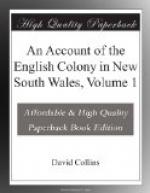Their noses are flat, nostrils wide, eyes much sunk in the head, and covered with thick eyebrows; in addition to which, they wear tied round the head, a net the breadth of the forehead, made of the fur of the opussum, which, when wishing to see very clearly, I have observed them draw over the eyebrows, thereby contracting the light. Their lips are thick, and the mouth extravagantly wide; but when opened discovering two rows of white, even, and sound teeth. Many had very prominent jaws; and there was one man who, but for the gift of speech, might very well have passed for an orangoutang. He was remarkably hairy; his arms appeared of an uncommon length; in his gait he was not perfectly upright; and in his whole manner seemed to have more of the brute and less of the human species about him than any of his countrymen. Those who have been in that country will, from this outline of him, recollect old We-rahng.
APPENDIX III—HABITATIONS
Their habitations are as rude as imagination can conceive. The hut of the woodman is made of the bark of a single tree, bent in the middle, and placed on its two ends on the ground, affording shelter to only one miserable tenant. These they never carry about with them; for where we found the hut, we constantly found the tree from which it had been taken withered and dead. On the sea-coast the huts were larger, formed of pieces of bark from several trees put together in the form of an oven with an entrance, and large enough to hold six or eight people. Their fire was always at the mouth of the hut, rather within than without; and the interior was in general the nastiest smoke-dried place that could be conceived. Their unserviceable canoes were commonly broken up and applied to this use. Beside these bark huts, they made use of excavations in the rock; and as the situations of these were various, they could always choose them out of the reach of wind and rain. At the mouths of these excavations we noticed a luxuriancy of soil; and on turning up the ground, found it rich with shells and other manure. These proved a valuable resource to us, and many loads of shells were burnt into lime, while the other parts were wheeled into our gardens.
When in the woods I seldom met with a hut, but at the mouth of it was found an ant’s nest, the dwelling of a tribe of insects about an inch in length, armed with a pair of forceps and a sting, which they applied, as many found to their cost, with a severity equal to a wound made by a knife. We conjectured, that these vermin had been drawn together by the bones and fragments of a venison feast, which had been left by the hunter.
In their huts and in their caves they lie down indiscriminately mixed, men, women, and children together; and appear to possess under them much the same enjoyment as may be supposed to be found by the brute beast in his den, shelter from the weather, and, if not disturbed by external enemies, the comfort of sleep.




